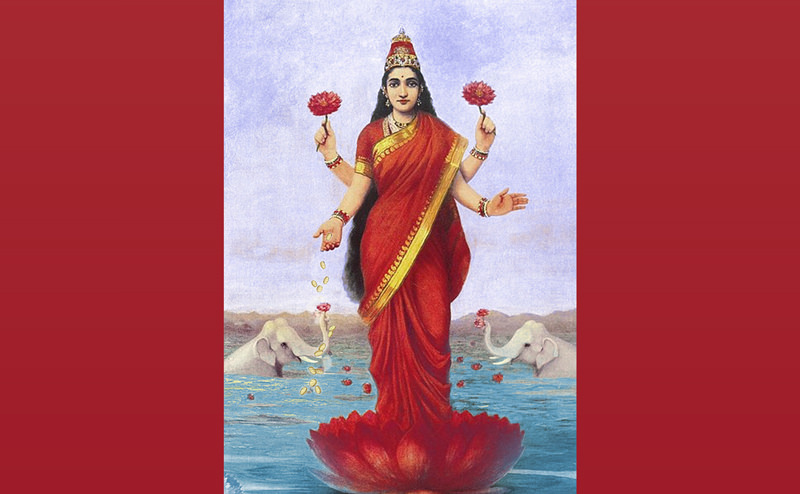Shri Lakshmi
Goddess of Abundance and Auspiciousness
by Madhulika Khandelwal


Shri Lakshmi is widely revered in India as the goddess of abundance, auspiciousness, and beauty. The name Lakshmi is synonymous with Sanskrit words like “saubhagya” (good fortune), “samriddhi” (prosperity), and “saundarya” (beauty). The title Shri represents the principle of auspiciousness and abundance, and is one of Goddess Lakshmi’s names as well. Mahalakshmi, the great Lakshmi, showers various kinds of bounty on her devotees—she bestows abundant blessings, brings forth benevolence and good fortune, and grants knowledge. As Siddha Yogis, we can understand that the prosperity Mahalakshmi grants is as much an inner wealth as it as an outer one; she supports us to create a beautiful world, both internally and all around us. Our innate virtues, the sadgunas, reflect divine qualities of Shri Lakshmi, and when we make self-effort to affirm and cultivate these virtues in our actions, she imparts her blessings as the fruits of sadhana.
Mahalakshmi is believed to have taken birth out of the churning of the Ocean of Milk (Kshir-Sagar Manthan), a mythical event in the Indian scriptures, depicting the struggle between the gods and demons to obtain amrit, the elixir of life. When Mahalakshmi emerged from this churning of the ocean, all the gods and demons beheld this beatific, beautiful, and benevolent form of the goddess with awe and reverence. On a symbolic level, this churning of the ocean represents our struggle between succumbing to our inner demons and strengthening our virtues, and Mahalakshmi is symbolic of God’s grace, which protects our inner virtues and sustains them as a divine force.
In classic images of Shri Lakshmi, she is shown as emerging from the ocean of supreme Consciousness, firmly established on a lotus flower, which represents purity and spiritual knowledge. Elephants, symbolizing strength, are shown offering worship to her. Goddess Lakshmi has many arms, each holding a symbolic object: a discus (chakra) to decimate her enemies; a flower (pushpa), indicating that she bestows knowledge; a conch-shell (shankha) with which she makes auspicious proclamations; and a stream of gold coins to represent the prosperity she grants at all levels. Those who worship Shri Lakshmi have a commitment to sustain the abundance and beauty she brings to our lives. Like most other major gods and goddesses, Mahalakshmi also has a vehicle (vahan), which for her is the owl (uluka), symbolizing the qualities of vigilance and wisdom.
Mahalakshmi is described as the eternal companion of Lord Vishnu—the sustaining force of the universe—and, acting as his creative energy, she carries out his divine purpose. She is traditionally said to have eight forms—the Ashtalakshmi—and each of these forms represents a particular facet of her abundant grace. For example, as Shri Adi-Lakshmi she is the goddess who is at the root of everything sentient and insentient; as Shri Vijaya-Lakshmi she blesses the struggles of her devotees and grants them victory and successful outcomes. Another form of Mahalakshmi is known as Shri Santana Lakshmi, in which the goddess is the beneficent mother who is a fierce protector of her children. On the Siddha Yoga path, we honor the Ashtalakshmi in June, the month of Gurumayi Chidvilasananda’s birthday. (To read more about all eight forms of Mahalakshmi, click here.)
Through the ages, the sages and saints of India have composed many hymns and songs praising Goddess Lakshmi, adoring her beauty, and extolling her generosity and compassion. By focusing on the beneficent image of Mahalakshmi, we recognize and invoke this goddess as a manifestation of the divine cosmic energy.
Verse 7 of Shri Mahalakshmyashtakam Stotram says:
padmāsana-sthite devi parabrahma-svarūpiṇi ।
parameśi jagan-mātar mahālakṣmi namo ‘stu te
mahālakṣmi namo ‘stu te ॥
O Goddess, seated on a lotus, embodiment of the absolute Brahman,
O supreme Goddess Mahalakshmi,
mother of the universe, salutations to you.1
Many people worship the supreme Goddess in the form of Mahalakshmi every day; however, special prayers are offered to her during the festivals of Navaratri, the “nine nights” of the Goddess, and Deepavali, the celebration of God’s light illuminating our homes and lives. For seekers of the Truth, worshipping Mahalakshmi with love and devotion carries great significance in their sadhana, their spiritual journey. To express devotion to Shri Mahalakshmi is to honor a form of the indwelling goddess Kundalini Shakti, who is awakened by the Siddha Yoga Guru and who continually guides our sadhana as living grace from within.
During this time of Navaratri, we can honor Shri Mahalakshmi by reciting hymns like Shri Mahalakshmyashtakam Stotram, recognizing her presence in Mother Nature, and cultivating the sadgunas, the virtues, throughout the activities of our daily life.




